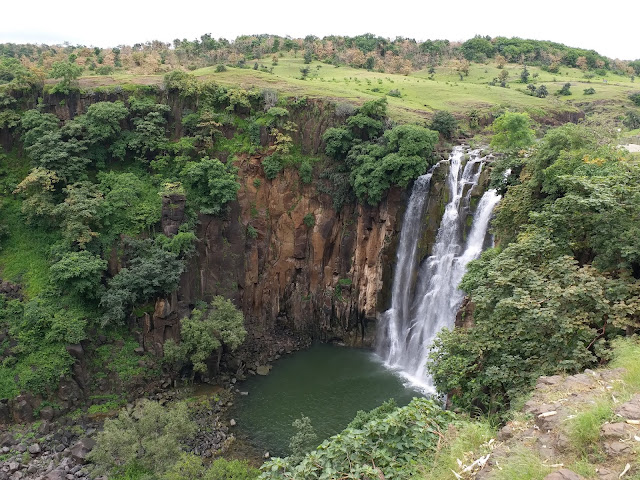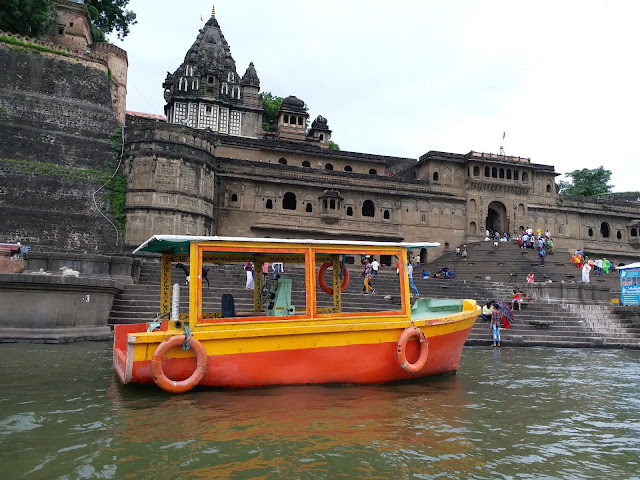Monsoon is always a good time to visit the
central Indian highlands. This is the time of the year when the rolling hills in
the region are painted with mossy green and the dark clouds bring the
temperature down. This monsoon we decided to visit the Malwa Plateau – the
famous highland nestled at the foothills of Vindhya Mountains.
 |
| Monsoon Greenery - View from Choral Dam |
Malwa is rich in history. It’s the region
where the great king Vikramaditya reigned. It’s the birthplace of poet
Kalidasa. Later in modern times Malwa rose to prominence once again through the
patronage of Rajmata Ahilya Devi, who ruled from Maheshwar near Indore.
We planned for an extended weekend trip of 3
days around Indore covering Choral Dam, Patalpaani waterfall, Omkareswar &
Maheshwar.
Choral Dam
Our trip started with a surprise. Our Jet
Airways flight to Indore happened to be their first flight in CCU-IDR route. So
we got a grand reception at the boarding gates, we were greeted with chocolates
and some beautifully decorated yellow roses, the flowers were really gorgeous.
After a couple of hour’s flight when we landed at IDR airport the aircraft was given
a salute with water cannons, which were a sight to behold.
We had our car waiting for us at the
airport, and drove straight towards Choral Dam & resort which is located
near MHOW, around 40 kilometers from Indore.
 |
| Local Fishermen at Choral Dam |
MHOW cantonment is a treat to watch. It’s a
typical squeaky clean cantonment town, with great buildings and history
associated with it. We reached Choral resort within an hour. MPTDC has set up a
nice sprawling resort by the banks of Choral Dam. The dam has been constructed
over the Choral River. During monsoon the lake with dark clouds hovering over
the water and wooded hills on the background looked absolutely enticing.
The afternoon was spent with some aimless
walk around the lake. Local fishermen were pretty busy looking for their catch
on the lake. We saw a lot of them, sailing with their country boat on the vast
lake. Boating is also a popular option at Choral. We could see weekend crowd
enjoying their ride at the placid waters. A colorful sunset marked the end of
our day at Choral.
 |
| Sunset at Choral Dam |
Experiencing a heritage Railway at PatalPani
The next morning our first destination was Patalpaani waterfall. Our added attraction to visit Patalpaani waterfall was to also see the famous meter gauge train chugging along the Vindhya Mountains. The meter gauge track was an engineering marvel from pre independence era. It connected Indore at Malwa plateau with the plains of Maharashtra at Khandwa, crossing the mighty Vindhyas. The route between Patalpaani and Kalakund is the most scenic section of this route where the track winds its way uphill through the ghat section. As a bonus the passengers also get a glimpse of the mighty Patalpaani waterfall from the train.
The next morning our first destination was Patalpaani waterfall. Our added attraction to visit Patalpaani waterfall was to also see the famous meter gauge train chugging along the Vindhya Mountains. The meter gauge track was an engineering marvel from pre independence era. It connected Indore at Malwa plateau with the plains of Maharashtra at Khandwa, crossing the mighty Vindhyas. The route between Patalpaani and Kalakund is the most scenic section of this route where the track winds its way uphill through the ghat section. As a bonus the passengers also get a glimpse of the mighty Patalpaani waterfall from the train.
During monsoon Patalpaani waterfall was at
its full glory. At Patalpaani, Choral River, leaps from a height of 300 meters
to form this waterfall, and then meanders its way through a narrow ravine in
the woods.
 |
| Pataalpani Waterfall at Monsoon |
As we were enjoying the waterfall, the MHOW
– Sanawad meter gauge passenger also arrived and slowly chugged along the ghats.
With the plunge of Patalpaani at one side, and the rustic meter gauge train on
the other side, it was the most magical picture one could draw in nature’s
canvas.
 |
| Sanawad Passenger at Pataalpani |
Omkareswar Jyotirlinga
Soon after the train left we started our journey towards Omkareswar. Omkareswar is a busy pilgrimage town on the banks of river Narmada. The famous Jyotirlinga is situated in an OM shaped island in the middle of Narmada, which can be reached via a hanging bridge on foot. The view of majestic Narmada flanked by Vindhya hills on either side, from that bridge is magical.
 |
| The Scenic Omkareswar Jyotirlinga |
The temple can also be reached via
mechanized boat taken from any of the ghats by the banks of Narmada. The boats
in this region are pretty colorful and looked pretty enticing in the middle of
clear blue Narmada water. The main temple is centuries old but with the ornate
carvings in its wall, still looks as majestic as ever.
It was a Sunday, so the place was brimming
with pilgrims all over nearby places. There was a long queue in front of the
sanctum sanatorium, and it looked standing on that queue might take few hours.
So we decided to take VIP tickets sold at a premium, and visited the deity. Not
the ideal way to visit the almighty but when you do not have enough time that
was possibly the only way out.
 |
| Colorful boats dot the Narmada River |
The town itself with holy cows, saffron
flags, and omnipresent pilgrims looked totally imbued with faith. There is a
magic in these kind of place, as it slowly grows on you, and the same happened
with us as well. As we spent more and more time at Omkareswar we started to
like the madness of the place. But we had to return back to Choral, which is
almost a couple of hours drive, so decided to return back well before the sun
down.
Next Day - Towards Maheshwar
The next day our destination was Maheshwar,
to experience the majestic fort built on the banks of Narmada by Rajmata Ahilyabai.
From Choral we once again had to cross the
Vindhya Mountain, this time through the famous Vanchu point, which provided a
mesmerizing view of the rolling hills and the plains below.
 |
| Vindhya Mountain from Vanchu Point Maheswar |
Compared to Omkareswar, Maheshwar is a
sleepy town, centered on the Ahilyabai Fort.
The fort is grand. The fort along with the
ghat in front of it has to be the most scenic waterfront in whole India. It
oozes heritage. The fort itself is extremely well maintained, with strong
walls, & intricately carved temples & pillars. The grandeur of the
palace and the temple inside it reminds people of the golden era of the Holkar
dynasty, led by Rajmata Ahilyabai.
 |
| Ahilyabai Fort as seen from the ghat |
Ahileshwar temple dedicated to lord Shiva
is the main temple complex inside the fort. It’s still an active temple, used
by both the local people and the royal family who lives inside the fort complex.
The temple with its intricately carved granite walls, is an epitome of the
Maratha architecture.
The Legacy of Maheshwar
The majestic fort, and the beautiful ghat
with its well-designed stairs going down to the languid Narmada in front of it,
creates a picturesque setting. A boat ride along the Narmada to look at the
daily chores on the ghats couldn’t have been missed. The boat ride along
Narmada offered us the best lookout points to enjoy the majestic beauty of the
Ahilyabai fort. Lots of devotees were taking a holy deep in the sacred waters
of Narmada. The chants of the devotees, the cool breeze of Narmada and the
grandeur of the mediaeval fort on the backdrop created a surreal effect.
 |
| The fort as seen from Narmada at Maheshwar |
Maheshwar is also famous for the Maheswari
Silk sarees. A lot of families here still earn their livelihood by weaving this
piece of art. Most of them are completely handmade and the motifs on the Sarees
are inspired by the carvings made on the majestic walls of the Ahileshwar
temple and Ahilyabai fort.
The tradition of Saree weaving was
patronized by Rajmata Ahilyabai, which helped Maheshwar become one of the
famous seats for silk sarees in India.
We visited one such weaver’s house and
bought us a handmade silk cotton Saree as a memory of visiting this rich
historic place.
 |
| Temple Carvings Maheswar - which inspires Maheswari Weavers |
We had our flight to Kolkata from Indore
that afternoon, so even though we wanted to stay a few hours more, and enjoy a
Sandhyarati on the banks of Narmada, we had to give that a miss. So we started
our journey back towards home, leaving behind the rich legacy of Malwa. This
region with its great blend of natural beauty and rich history, is certainly an
important place in our ‘Incredible India’.